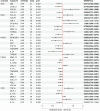Exploring the impact of diet, sleep, and metabolomic pathways on Glaucoma subtypes: insights from Mendelian randomization and cross-sectional analyses
- PMID: 40640923
- PMCID: PMC12243165
- DOI: 10.1186/s12986-025-00967-4
Exploring the impact of diet, sleep, and metabolomic pathways on Glaucoma subtypes: insights from Mendelian randomization and cross-sectional analyses
Abstract
Background: Glaucoma is a leading cause of irreversible blindness, influenced by systemic and lifestyle factors. This study investigates the causal relationships between dietary habits, sleep traits, amino acids, metabolites, and inflammatory factors with glaucoma subtypes using Mendelian randomization (MR) and validates findings through cross-sectional analysis.
Methods: MR analysis assessed the causal effects of 226 dietary factors, 11 sleep traits, 20 amino acids, 1400 metabolites, and 91 inflammatory factors on five glaucoma subtypes (NTG, POAG, PACG, NVG, XFG). Mediation MR analysis explored the role of amino acids and inflammatory factors in these relationships. Validation was conducted using NHANES cross-sectional data.
Results: High-fat, high-calorie diets increased glaucoma risk, while antioxidant-rich foods and better sleep quality reduced it. Key mediators included proline, tyrosine, IL-1 A, and PDL1. NHANES data confirmed lower intake of vitamins A and C, higher water consumption among glaucoma patients, and significant sleep-related associations.
Conclusion: Our findings highlight the role of balanced diets and optimized sleep patterns in glaucoma prevention and management. This study provides evidence for targeted lifestyle interventions focusing on metabolic and inflammatory pathways to mitigate glaucoma risk.
Keywords: Amino acids; Dietary habits; Glaucoma; Inflammatory factors; Lifestyle interventions; Mendelian randomization; Metabolomics; NHANES; Neuroprotection.; Sleep traits.
© 2025. The Author(s).
Conflict of interest statement
Declarations. Ethics approval and consent to participate: This study used publicly available data from the National Health and Nutrition Examination Survey (NHANES), which is conducted by the National Center for Health Statistics (NCHS). NHANES has received ethical approval from the NCHS Research Ethics Review Board (ERB). The study was approved by the NCHS Ethics Review Board(Protocol #98 − 12). This study adhered to the ethical principles outlined in the Declaration of Helsinki. Competing interests: The authors declare no competing interests. Informed consent: Not applicable.
Figures





Similar articles
-
Genetic association of lipid traits and lipid-related drug targets with normal tension glaucoma: a Mendelian randomization study for predictive preventive and personalized medicine.EPMA J. 2024 Jul 13;15(3):511-524. doi: 10.1007/s13167-024-00373-5. eCollection 2024 Sep. EPMA J. 2024. PMID: 39239107
-
Relationships between Frailty and the Risk of Glaucoma in Middle-aged and Older Adults.Ophthalmol Glaucoma. 2025 Jan-Feb;8(1):73-82. doi: 10.1016/j.ogla.2024.09.006. Epub 2024 Oct 5. Ophthalmol Glaucoma. 2025. PMID: 39370105
-
Inflammatory cytokines mediate the gut microbiota-EGPA subtype link: a Mendelian randomization study.Clin Rheumatol. 2025 Jul;44(7):3061-3071. doi: 10.1007/s10067-025-07526-5. Epub 2025 Jun 12. Clin Rheumatol. 2025. PMID: 40500572
-
Multifaceted behavioral interventions to improve topical glaucoma therapy adherence in adults.Cochrane Database Syst Rev. 2025 Jun 11;6(6):CD015788. doi: 10.1002/14651858.CD015788.pub2. Cochrane Database Syst Rev. 2025. PMID: 40497459 Review.
-
Effects of a gluten-reduced or gluten-free diet for the primary prevention of cardiovascular disease.Cochrane Database Syst Rev. 2022 Feb 24;2(2):CD013556. doi: 10.1002/14651858.CD013556.pub2. Cochrane Database Syst Rev. 2022. PMID: 35199850 Free PMC article.
References
-
- Jayaram H, Kolko M, Friedman DS, Gazzard G. Glaucoma: now and beyond. Lancet. 2023;402(10414):1788–801. - PubMed
-
- Tham Y-C, Li X, Wong TY, Quigley HA, Aung T, Cheng C-Y. Global prevalence of glaucoma and projections of glaucoma burden through 2040: a systematic review and meta-analysis. Ophthalmology. 2014;121(11):2081–90. - PubMed
-
- Stein JD, Khawaja AP, Weizer JS. Glaucoma in Adults-Screening, diagnosis, and management: A review. JAMA. 2021;325(2):164–74. - PubMed
-
- Bou Ghanem GO, Wareham LK, Calkins DJ. Addressing neurodegeneration in glaucoma: mechanisms, challenges, and treatments. Prog Retin Eye Res. 2024;100:101261. - PubMed
LinkOut - more resources
Full Text Sources
Research Materials

